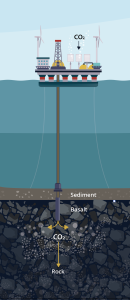This story was published as part of the 2024 Travel Fellowship Program to AAAS organized by the NASW Education Committee, providing science journalism practice and experience for undergraduate and graduate students.
Story by Josie Heimsoth
Mentored and edited by Laurel Hamers
DENVER – When it comes to saving our planet from being engulfed by greenhouse gasses, our oceans may hold the answers. Ocean-based carbon-capture has potential to amplify the sea’s ability to store carbon dioxide – oceans have already absorbed 30 percent of emissions from human activity since the industrial revolution. However, many worry about how some of the technologies will affect the health of our marine ecosystems.
During a Feb. 16 talk at the American Association for the Advancement of Science (AAAS) annual meeting, researchers discussed different ways the oceans can be used to sequester carbon from the atmosphere, as well as the potential concerns about these approaches.
For scientists around the world, there is an urgency to find a solution to limit global warming at 1.5 degrees Celsius. Quick and durable carbon sequestration can help, according to David Koweek, a chief scientist at Ocean Visions, a non-profit facilitating ocean-based climate solutions. “When I say durable, I mean stored away for long periods of time, say a hundred years or tens of thousands of years.”

The Solid Carbon concept is being researched by Ocean Networks Canada. The goal of the project is to safely sequester carbon dioxide as solid rock beneath the ocean floor. Credit: Ocean Networks Canada
“We need to begin to remove CO2 from the atmosphere, probably by the end of this decade in order to keep the planet habitable for humans,” said Kate Moran, president of Ocean Networks Canada, a research and ocean observing facility at the University of Victoria. “If we didn’t have the ocean, we’d already be cooked.”
Blue carbon – CO2 captured from the atmosphere by marine plants and algae – is one method of carbon capture. Sea grasses, mud flats and eelgrass meadows can capture and hold greenhouse gasses for millions of years. According to a report published by Ocean Networks Canada, these undisturbed ecosystems can store these gasses at the gigatons scale. The organization wants to enhance the natural processes occurring in these plants to absorb more carbon.
Ocean Networks Canada has a platform that monitors live data with cameras to assess the environmental impacts of this system, Moran said. In September 2023, Ocean Networks Canada began a year-long project with a US-based ocean health company called Running Tide to research marine carbon removal and the potential effects of seaweed cultivation on the deep sea environment.
To do this, the researchers installed an observational platform with Running Tide’s carbon buoys and samples of kelp substrate at one of Ocean Networks Candada’s observatories. The project will investigate what happens to the seaweed after it sinks one kilometer below the surface, and the samples will be monitored using salinity, temperature and dissolved oxygen sensors. Remotely operated vehicles will observe changes in sediment composition and how the microbial communities are responding to the carbon buoys.
Ocean Networks Canada is leading a team of researchers to advance another method of carbon-capture, called the Solid Carbon project. This technology will remove atmospheric carbon dioxide by capturing it from the air and injecting it below the seafloor’s sediment layer. It will react with ocean basalt, a rock that covers nearly two-thirds of the Earth’s surface, and mineralize the CO2. Solid carbon has the potential to remove at least 20 gigatons of carbon a year, according to the Ocean Networks Canada report.
While natural climate solutions such as restoring a coastal wetland can play a role in climate mitigation, the carbon dioxide stored within these systems can easily be released through disturbance events like fires and storms, Koweek said. The idea of carbon-capture technology is once it’s stored, it ensures the carbon will be locked away for generations.
Despite the potential to eliminate these global warming gasses, some are especially concerned with this type of ocean based carbon-capture technology.
According to a report published by the Center for International Environmental Law, although CO2 can potentially be stored in a variety of different rock formations, including ocean basalt, there are variables that make it difficult to predict the behavior of the carbon underground. The limited research on the technology can make it difficult to predict carbon leakage pathways, and there’s no way of knowing how it will affect the ocean over time.
Researchers are determined to ensure the safety of these technologies to make the worst case scenarios improbable.
“We have to be capturing enough carbon dioxide to make a difference in the climate, and there is a risk for environmental impact,” Koweek said. “That’s why we need to start small with well designed field trials that allow us to understand, characterize and mitigate any environmental impacts from these activities.”
Expanding research in carbon-capture could lead to a successful climate solution, but there’s still lots of work that needs to be done. “We need to have everyone coming along with us as we develop these technologies,” Moran said.
Jocelyn Heimsoth is a senior at the University of Missouri - Columbia double-majoring in journalism and environmental science. She is a national park enthusiast with a passion for soil science. You can reach her at josiepaigeheimsoth@gmail.com.
Edited by: Laurel Hamers, University of Oregon
Top Image: Top Fish swim in a sanctuary near Papahānaumokuākea Marine National Monument, Hawaii. Credit: NOAA
Founded in 1934 with a mission to fight for the free flow of science news, NASW is an organization of ~ 3,000 professional journalists, authors, editors, producers, public information officers, students and people who write and produce material intended to inform the public about science, health, engineering, and technology. To learn more, visit www.nasw.org.

.png)

